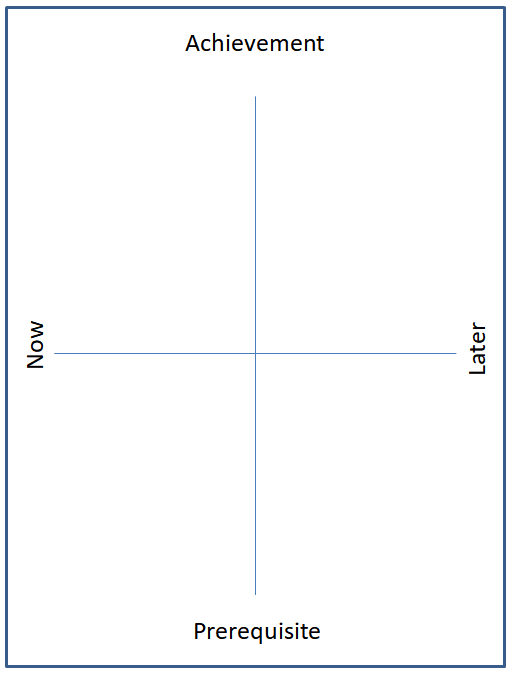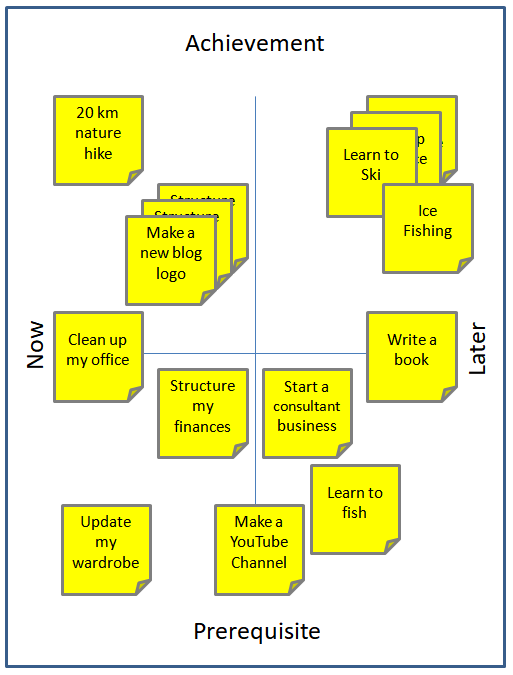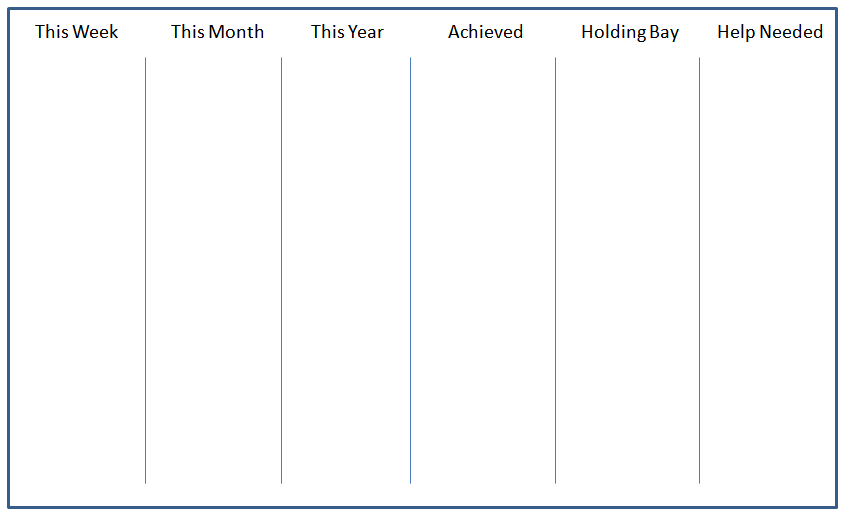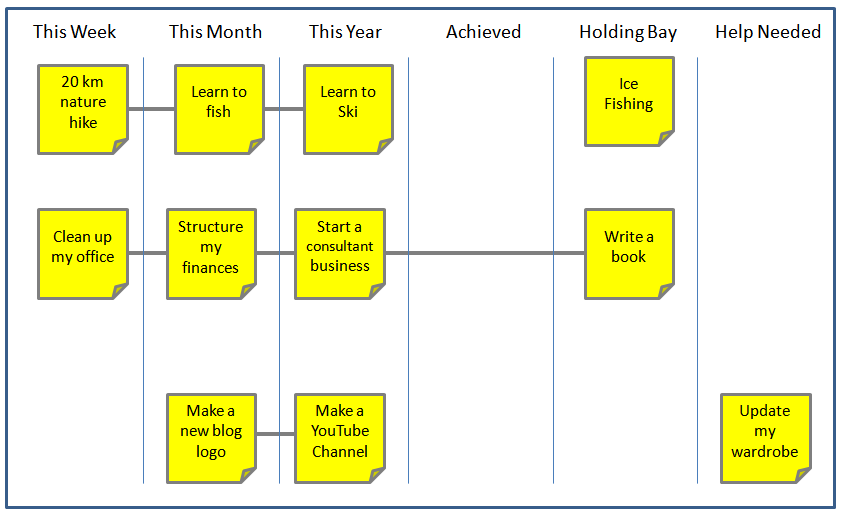There is a saying that goes “goals without plans are just dreams”. While true in a way, in that it’s hard to act on something when we have not properly defined it and how we intend to get there, dreams are a core part of our selves. They are the distant desires, the “what-ifs” and the coping mechanisms that allow us to continue on despite not being happy with our current situations.
But setting up goals, making those plans, that’s a big step for many people. We have a subconscious catalog of our dreams, but bringing those forward is hard, especially because we don’t always dare to speak of our dreams. Personally, I sometimes feel my dreams are fragile, and to speak of them would subject them to damage, perhaps destroying them.
If you’re good and ready, at least comfortable at the current time, the following exercise can help you focus your thoughts. It’s important that you don’t feel the need to act on your dreams just yet. You’re just going to put them to words.
The Set Up
Get yourself some pens or pencils, some sticky notes and a sheet of paper. Draw a cross on the paper, separating it into four sections, but leave a bit of room at the edges to write on. Write the following words at the terminus of each arm of the cross:
- Top: Achievement
- Bottom: Prerequisite
- Left: Now
- Right: Later
This should give you an image looking a bit like the one below:

Sticky Dreams
Now take the sticky notes and write down in as few words as possible all the things you’ve thought about doing, anything that makes you feel happy or fulfilled. Mountain climbing? Visiting the Niagara Falls? Solve the climate crisis? Eat ramen at twelve different shops in Tokyo? Shake hands with your country’s leader? Visit a distant relative? Change your hair color? Learn how to make barrista-quality coffee? Find out more about beer?
The sky’s the limit here. The main thing is to be honest to yourself and allow yourself to write down those things that make you feel accomplished, that you’d love to share with others, or that plain make you feel good about yourself. It’s not about being able to do those things, not just now. It’s only about giving you a catalog of things to aspire to. And it’s ok to take some time for this, and to come back later and add more. Often I find that after a day or two I am actually much more honest to myself and willing to admit to dreams and desires I did not when I first sat down to do this.
You don’t need to do this all physically, you can also use a digital tool like Trello or One Note to organize your thoughts, but there’s something personal and private about using physical media. It’s like doing this on paper is more connected to the artistic side of the brain, and allows you to be more free and honest in writing these things down.
Once you’re done look down at the notes you’ve made, and take some time to take in the dreams you have. Maybe you’ll find out you are much more adventurous or multifaceted than you thought you’d be, or you might be disappointed you’ve less dreams that you had hoped for. You could find out already that you’d want different hobbies, different job, different anything. It’s ok to feel that way but hold off on those feelings just now.
Writing down all those hopes and dreams may make you feel a bit euphoric and give you the immediate desire to act on them, but that may lead to unstructured attempts, and then disappointment. So hold off on acting on them, instead feel free to revel a bit in anticipation.
Filling Up The Paper
Now comes the time to look at each little sticky note and see how you feel about them. Each dream will hover in between being something we could do right now if we wanted (but didn’t, for whatever reason) and something that feels like it is far away in the future. In addition, each of those dreams will be an achievement we’re hunting after (“I want to vercome my fear of horses”) or a prerequisite, something we need to do to prepare for, or clear the way, to achieve something else (“I want an RV camper so I can go tour the country”)
Try and find some of the more extreme examples of each among your dreams, and place them on the paper. Then, try and find room for each of your dreams along the axes of now/later and achievement/prerequisite.
It should look a little like this:

This will get you a cloud of dreams and wants and needs which represents a bit what you’d do with your life given infinite resources and time. I always have the feeling that one of the reasons I don’t achieve all of those things is because there’s just so many of them, and it’s hard to organize them and put them in some sort of “achievable order” to work on.
So that’s what we’re doing next.
A Little Bit Of Scrum
Originally developed for software development, SCRUM or Agile SCRUM, is basically a technique of organizing tasks in such a way that you can achieve meaningful things as a team. Even when you’re alone, the very concept of it is a very nice way of structuring what you want to achieve and have honest and open conversations with yourself.
You see, there are many reasons why we (as human beings) don’t do the things we want. We feel we cannot do them yet and don’t want to waste our “one shot at getting it right”. We feel we aren’t smart, rich, strong or connected enough, and we’d rather fondle the dream than face a reality where we try and fail at achieving it. We may also sometimes just give ourselves too much to do and too high expectations, leading to paralyzing ourselves. We’re not good at being really honest with ourselves.
So first off we’re going to set up a new sheet of paper. Here we are looking into a bit more concrete matters, one step at a time. First make a number of lines on the paper, so you make 6 columns. Name the first three columns in order as “This Week”, “This Month”, “This Year”. The fourth one is “Achieved”, the fifth is “Holding Bay” and the sixth is “Help Needed”.
That would look a little like this:

First take your dreams and see if you can find a number that have a connection with each other, preferably a dependency. And stick them onto your scrum sheet. Connect these tasks together so you not only have a clear path to get through your dreams, but also a feeling of continuity between your goals.
For example, I feel I need to clear out my office before I can start a consultancy business. And I would love to write a book, but I want to have anecdotes from the consultancy business to give it some weight. So then I could achieve one of those things this week (cleaning my office) and the second (starting the business) this year, I feel. I don’t know when I could write the book, so for now that goes into the holding bay. I take a pencil and draw a line from one to the other, to show the connection.
Sometimes, you’re going to find a dream that you simply cannot tackle without getting some additional help. Like a project that needs funding, or some form of job experience, or emotional support when you need to confront something from your past. Put those in the “Help Needed” column, and then put a new task in the one week or one month column where you find the help you need. This way, you don’t get to put things away just because they are difficult, but instead reduce them to the tasks required to achieve them and a way of taking away blockers.
In other words, turn things you cannot control into one or more tasks where you do have influence on.

As you can see I could find a clear set of prerequisities on some of my dreams, and when I laid them out like this, it made much more sense how I could approach things, and why I put off certain jobs, like restructuring my finance because I couldn’t find anything in my messy office. Or how I need some help updating my wardrobe because I haven’t bought new business attire for a long time and I have no idea what is acceptable or would fit me well…guess I will need to put a sticky note for this week to find someone who can give me some advice on clothing.
Fishing and Skiing wouldn’t make much sense together in ordinary situations, but when you realize you’ll need that to be able to go ice fishing some day, suddenly you can bring up more motivation to get some of those things done that you didn’t really understand why you wanted them. Many times we understand subconsciously very well the order in which we should do things, but we mess it up when we don’t organize our thoughts properly.
Making A Day Out Of It
Seeing your goals projected like this makes them feel achievable, and much closer than they were before. When this happens you’ll feel new motivation and purpose.
Pick an hour or so each week, and reorganize the board. Move things you’ve done to completed, move things further in the year closer to you. If you didn’t do something last week, put it up for this week, but ask yourself why you didn’t get to it. Time? Fear? Stress? It’s important to start a dialogue with yourself and find out what’s really keeping you from doing the things you want.
You may find out that some of your “easy goals” for this week require help, that there’s more hidden under the surface than you thought initially, and that’s ok. The first step of any plan is to realize that it won’t survive initial contact with reality. Plans change, dreams change, and as a result, so will you.
